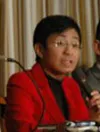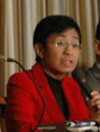“The e-mail came in at 8.48 p.m.,” Philippine journalist Maria Ressa told a hushed audience at CPJ’s panel discussion, Press Freedom: On the Frontlines and Online, this morning at the Foreign Correspondents Club of Japan in Tokyo. She was describing how the first photo from the November massacre in Maguindanao province reached the mainstream Philippine media. Thirty-two journalists and media workers were slaughtered in the deadliest single attack that CPJ has ever recorded.

“That was a citizen journalist. The picture was taken as though someone was holding a cell phone at waist height,” she said. That anonymous individual—probably a member of the police or the local armed forces, Ressa said—risked his or her life. Taking photos from sensitive news scenes and sending those images via Internet exemplified the type of reporting under dangerous conditions that CPJ documented time and again in its annual survey, Attacks on the Press.
Local journalists were not surprised that colleagues were killed; it’s a fact of life in the Philippines, according to Ressa, head of news and current affairs Philippine TV network ABS-CBN, who flew to Tokyo on Monday to take part in the panel. But the sheer scale of the killings was shocking. When the rest of the world learned what had happened, people realized the depth of impunity in journalist murders in the Philippines. The e-mail that helped break the story is a reminder that citizen journalists are also on the front lines of press freedom.
(Reporting from Tokyo)
